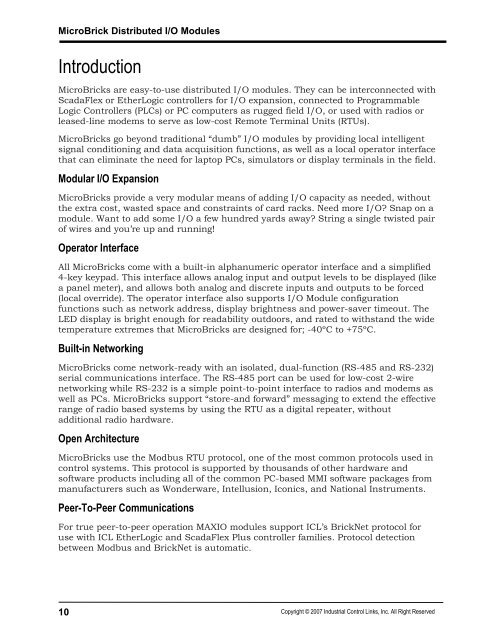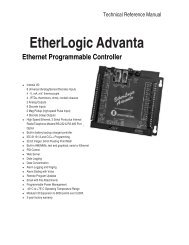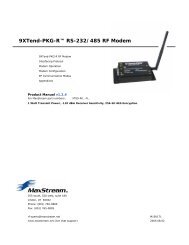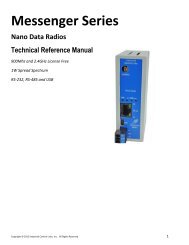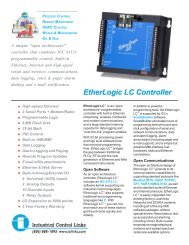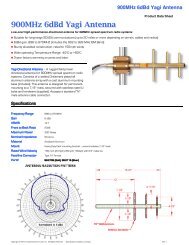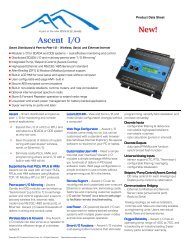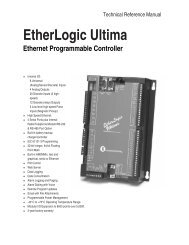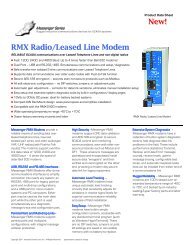MicroBrick I/O - Industrial Control Links
MicroBrick I/O - Industrial Control Links
MicroBrick I/O - Industrial Control Links
You also want an ePaper? Increase the reach of your titles
YUMPU automatically turns print PDFs into web optimized ePapers that Google loves.
<strong>MicroBrick</strong> Distributed I/O ModulesIntroduction<strong>MicroBrick</strong>s are easy-to-use distributed I/O modules. They can be interconnected withScadaFlex or EtherLogic controllers for I/O expansion, connected to ProgrammableLogic <strong>Control</strong>lers (PLCs) or PC computers as rugged field I/O, or used with radios orleased-line modems to serve as low-cost Remote Terminal Units (RTUs).<strong>MicroBrick</strong>s go beyond traditional “dumb” I/O modules by providing local intelligentsignal conditioning and data acquisition functions, as well as a local operator interfacethat can eliminate the need for laptop PCs, simulators or display terminals in the field.Modular I/O Expansion<strong>MicroBrick</strong>s provide a very modular means of adding I/O capacity as needed, withoutthe extra cost, wasted space and constraints of card racks. Need more I/O? Snap on amodule. Want to add some I/O a few hundred yards away? String a single twisted pairof wires and you’re up and running!Operator InterfaceAll <strong>MicroBrick</strong>s come with a built-in alphanumeric operator interface and a simplified4-key keypad. This interface allows analog input and output levels to be displayed (likea panel meter), and allows both analog and discrete inputs and outputs to be forced(local override). The operator interface also supports I/O Module configurationfunctions such as network address, display brightness and power-saver timeout. TheLED display is bright enough for readability outdoors, and rated to withstand the widetemperature extremes that <strong>MicroBrick</strong>s are designed for; -40ºC to +75ºC.Built-in Networking<strong>MicroBrick</strong>s come network-ready with an isolated, dual-function (RS-485 and RS-232)serial communications interface. The RS-485 port can be used for low-cost 2-wirenetworking while RS-232 is a simple point-to-point interface to radios and modems aswell as PCs. <strong>MicroBrick</strong>s support “store-and forward” messaging to extend the effectiverange of radio based systems by using the RTU as a digital repeater, withoutadditional radio hardware.Open Architecture<strong>MicroBrick</strong>s use the Modbus RTU protocol, one of the most common protocols used incontrol systems. This protocol is supported by thousands of other hardware andsoftware products including all of the common PC-based MMI software packages frommanufacturers such as Wonderware, Intellusion, Iconics, and National Instruments.Peer-To-Peer CommunicationsFor true peer-to-peer operation MAXIO modules support ICL’s BrickNet protocol foruse with ICL EtherLogic and ScadaFlex Plus controller families. Protocol detectionbetween Modbus and BrickNet is automatic.10Copyright © 2007 <strong>Industrial</strong> <strong>Control</strong> <strong>Links</strong>, Inc. All Right Reserved


